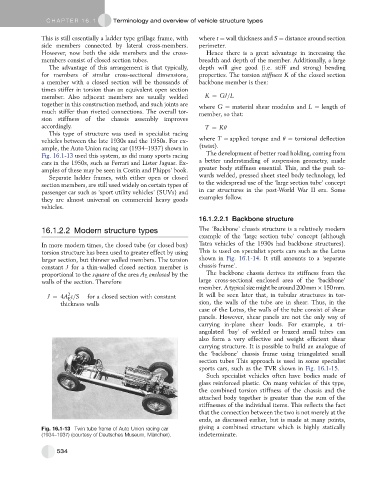Page 525 - Automotive Engineering Powertrain Chassis System and Vehicle Body
P. 525
CHAP TER 1 6. 1 Terminology and overview of vehicle structure types
This is still essentially a ladder type grillage frame, with where t ¼ wall thickness and S ¼ distance around section
side members connected by lateral cross-members. perimeter.
However, now both the side members and the cross- Hence there is a great advantage in increasing the
members consist of closed section tubes. breadth and depth of the member. Additionally, a large
The advantage of this arrangement is that typically, depth will give good (i.e. stiff and strong) bending
for members of similar cross-sectional dimensions, properties. The torsion stiffness K of the closed section
a member with a closed section will be thousands of backbone member is then:
times stiffer in torsion than an equivalent open section
member. Also adjacent members are usually welded K ¼ GJ=L
together in this construction method, and such joints are where G ¼ material shear modulus and L ¼ length of
much stiffer than riveted connections. The overall tor- member, so that:
sion stiffness of the chassis assembly improves
accordingly. T ¼ Kq
This type of structure was used in specialist racing
vehicles between the late 1930s and the 1950s. For ex- where T ¼ applied torque and q ¼ torsional deflection
ample, the Auto Union racing car (1934–1937) shown in (twist).
Fig. 16.1-13 used this system, as did many sports racing The development of better road holding, coming from
cars in the 1950s, such as Ferrari and Lister Jaguar. Ex- a better understanding of suspension geometry, made
amples of these may be seen in Costin and Phipps’ book. greater body stiffness essential. This, and the push to-
Separate ladder frames, with either open or closed wards welded, pressed sheet steel body technology, led
section members, are still used widely on certain types of to the widespread use of the ‘large section tube’ concept
passenger car such as ‘sport utility vehicles’ (SUVs) and in car structures in the post-World War II era. Some
they are almost universal on commercial heavy goods examples follow.
vehicles.
16.1.2.2.1 Backbone structure
16.1.2.2 Modern structure types The ‘Backbone’ chassis structure is a relatively modern
example of the ‘large section tube’ concept (although
In more modern times, the closed tube (or closed box) Tatra vehicles of the 1930s had backbone structures).
torsion structure has been used to greater effect by using This is used on specialist sports cars such as the Lotus
larger section, but thinner walled members. The torsion shown in Fig. 16.1-14. It still amounts to a ‘separate
constant J for a thin-walled closed section member is chassis frame’.
proportional to the square of the area A E enclosed by the The backbone chassis derives its stiffness from the
walls of the section. Therefore large cross-sectional enclosed area of the ‘backbone’
member. A typical size might be around 200mm 150 mm.
2
J ¼ 4A t=S for a closed section with constant It will be seen later that, in tubular structures in tor-
E
thickness walls sion, the walls of the tube are in shear. Thus, in the
case of the Lotus, the walls of the tube consist of shear
panels. However, shear panels are not the only way of
carrying in-plane shear loads. For example, a tri-
angulated ‘bay’ of welded or brazed small tubes can
also form a very effective and weight efficient shear
carrying structure. It is possible to build an analogue of
the ‘backbone’ chassis frame using triangulated small
section tubes This approach is used in some specialist
sports cars, such as the TVR shown in Fig. 16.1-15.
Such specialist vehicles often have bodies made of
glass reinforced plastic. On many vehicles of this type,
the combined torsion stiffness of the chassis and the
attached body together is greater than the sum of the
stiffnesses of the individual items. This reflects the fact
that the connection between the two is not merely at the
ends, as discussed earlier, but is made at many points,
Fig. 16.1-13 Twin tube frame of Auto Union racing car giving a combined structure which is highly statically
(1934–1937) (courtesy of Deutsches Museum, Mu ¨ nchen). indeterminate.
534

